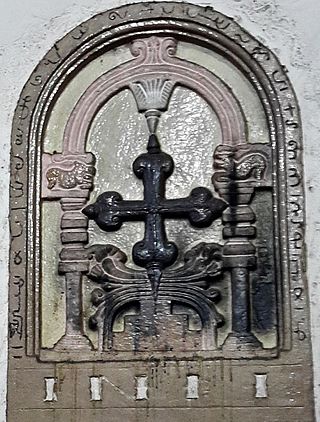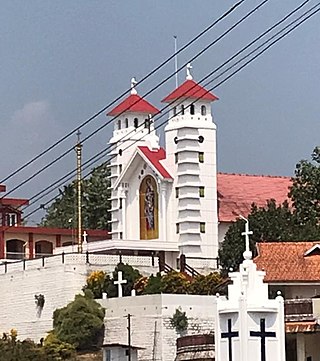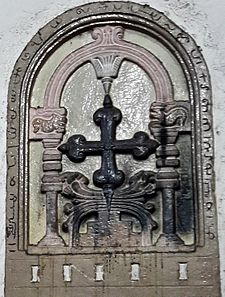
The Malankara Orthodox Syrian Church (MOSC) also known as the Indian Orthodox Church (IOC) or simply as the Malankara Church, is an autocephalous Oriental Orthodox church headquartered in Devalokam, near Kottayam, India. The church serves India's Saint Thomas Christian population. According to tradition, these communities originated in the missions of Thomas the Apostle in the 1st century. It employs the Malankara Rite, an Indian form of the West Syriac liturgical rite.

The Saint Thomas Christians, also called Syrian Christians of India, Marthoma Suriyani Nasrani, Malankara Nasrani, or Nasrani Mappila, are an ethno-religious community of Indian Christians in the state of Kerala, who, for the most part, employ the Eastern and Western liturgical rites of Syriac Christianity. They trace their origins to the evangelistic activity of Thomas the Apostle in the 1st century. The Saint Thomas Christians had been historically a part of the hierarchy of the Church of the East but are now divided into several different Eastern Catholic, Oriental Orthodox, Protestant, and independent bodies, each with their own liturgies and traditions. They are Keralites and speak Malayalam. Nasrani or Nazarene is a Syriac term for Christians, who were among the first converts to Christianity in the Near East.

The Synod of Diamper (Udayamperoor Synod) (Malayalam: ഉദയംപേരൂർ സൂനഹദോസ്, romanized: Udayampērūṟ Sūnahadōs), held at Udayamperoor (known as Diamper in non-vernacular sources) in June 1599, was a diocesan synod, or council, that created rules and regulations for the ancient Saint Thomas Christians (also known as Mar Thoma Nasranis) of the Malabar Coast, a part of modern-day Kerala state, India, formally subjugating them and downgrading their whole Metropolitanate of India as the Diocese of Angamale, a suffragan see to the Archdiocese of Goa administered by Latin Church Padroado missionaries. This synod also introduced forced Liturgical Latinisation and the eschewal of local practices and beliefs, leading to a significant ecclesial protest by Saint Thomas Christians known as Coonan Cross Oath and a subsequent schism in the mid-17th century.

The Chaldean Syrian Church of India is an Eastern Christian denomination, based in Thrissur, in India. It is organized as a metropolitan province of the Assyrian Church of the East, and represents traditional Christian communities of the East Syriac Rite along the Malabar Coast of India. It is headed by Mar Awgin Kuriakose.

The Malabar Independent Syrian Church (MISC) also known as the Thozhiyur Church, is a Christian church centred in Kerala, India. It is one of the churches of the Saint Thomas Christian community, which traces its origins to the evangelical activity of Thomas the Apostle in the 1st century.
Mar Dionysius I (Mar Thoma VI) (died 8 April 1808), was the 6th Metropolitan of the Malankara Syrian Church from 1765 until his death. A member of the Pakalomattom family (Thazhmon, Ayroor) he appealed to outside authorities to assert his position as the sole leader of the Malankara Church and to attempt to reunite all the Saint Thomas Christians.

The history of the Church of the East in India is dated to 52 AD by apocryphal sources and to the 9th century by the Quilon Syrian copper plates, the latter of which is considered the earliest reputable dating for Christians in the Indian subcontinent.

The Malankara Church, also known as Puthenkur, is the historic unified body of West Syriac Saint Thomas Christian denominations which claim ultimate origins from the missions of Thomas the Apostle. This community, under the leadership of Thoma I, opposed the Padroado Jesuits as well as the Propaganda Carmelites of the Latin Church, following the historical Coonan Cross Oath of 1653. The Malankara Church's divisions and branchings have resulted in present-day Churches that include the Jacobite Syrian Christian Church, the Malankara Orthodox Syrian Church, the Malankara Mar Thoma Syrian Church, the Malabar Independent Syrian Church, the Syro-Malankara Catholic Church, the Saint Thomas Anglicans of the Church of South India and the St. Thomas Evangelical Church of India.
Dioceses of the Church of the East, 1318–1552 were metropolitan provinces and dioceses of the Church of the East, during the period from 1318 to 1552. They were far fewer in number than during the period of the Church's greatest expansion in the tenth century. Between 1318 and 1552, the geographical horizons of the Church of the East, which had once stretched from Egypt to China, narrowed drastically. By 1552, with the exception of a number of East Syriac communities in India, the ecclesiastical jurisdiction of the Church of the East was confined to its original heartland in northern Mesopotamia.

The Metropolitanate of Shemsdin, created after the 1552 schism in the Church of the East, the predecessor to the Assyrian Church of the East, was the second most important ecclesiastical province of the Qudshanis patriarchate after the province of the patriarch himself. The metropolitans or matrans of Shemsdin traditionally took the name Hnanishoʿ and lived in the Shemsdin village of Mar Ishoʿin the sub-district of Rustaqa. There were around twelve metropolitans of Shemsdin between the sixteenth and twentieth centuries, most of whom were chosen by hereditary succession. The last metropolitan of Shemsdin, Mar Yosip Khnanisho died in Iraq in 1977, and the office of mutran lapsed on his death.
Diocese of Berwari was an East Syriac diocese of the Church of the East, existing between the 16th and 20th centuries and covering the region of Berwari.

The patriarch of the Church of the East is the patriarch, or leader and head bishop of the Church of the East. The position dates to the early centuries of Christianity within the Sassanid Empire, and the Church has been known by a variety of names, including the Church of the East, Nestorian Church, the Persian Church, the Sassanid Church, or East Syrian.

Metropolitanate of India was an East Syriac ecclesiastical province of the Church of the East, at least nominally, from the seventh to the sixteenth century. The Malabar region (Kerala) of India had long been home to a thriving Eastern Christian community, known as the Saint Thomas Christians. The community traces its origins to the evangelical activity of Thomas the Apostle in the 1st century. The Christian communities in India used the East Syriac Rite, the traditional liturgical rite of the Church of the East. They also adopted some aspects of Dyophysitism of Theodore of Mopsuestia, often inaccurately referred as Nestorianism, in accordance with theology of the Church of the East. It is unclear when the relation between Saint Thomas Christian and the Church of the East was established. Initially, they belonged to the metropolitan province of Fars, but were detached from that province in the 7th century, and again in the 8th, and given their own metropolitan bishop.
Mar Denha II was patriarch of the Church of the East from 1336/7 to 1381/2. Although no history of his reign has survived, references in a number of Nestorian, Jacobite and Moslem sources provide some details of his patriarchate.
Shimun Yahballaha, also designated in some modern historiographical works as Yahballaha IV, or even Yahballaha V, was Patriarch of the pro-Catholic line of primates of the Church of the East, from c. 1572 to c. 1580. In primary sources, he is mentioned as patriarch Shimun by several inscriptions dated from 1572 to 1577, while his additional name Yahballaha is recorded in a later report, submitted to Rome (1581) by metropolitan Eliya. The same report describes recently deceased patriarch Yahballaha Shimun as an elderly hierarch, who was elected to the patriarchal see sometime after the death of Abdisho IV Maron, but did not seek confirmation from Rome, due to his advanced age.

Mar Yaqob Abuna was one of the metropolitans of the Church of Malabar of the Saint Thomas Christians. In 1503, Mar Eliya V, the Catholicos Patriarch of the Church of the East consecrated three Bishops from the Monastery of Saint Eugene: Rabban David as Mar Yaballaha, Rabban George as Mar Denha, Rabban Masud as Mar Yaqob. The Patriarch sent these three new Bishops together with Mar Thomas to the lands of the Indians, and to the islands of the seas, which are within Dabag, and to Sin and Masin- Java, China and Maha china- Great China.

Mar Yohannan, also known as a monk Yoseph of Awgin, was Bishop of India, a metropolitan province of the Church of the East. In 1490, envoys of Saint Thomas Christians from the Malabar Coast in India traveled to Mesopotamia and arrived in Gazarta, bringing appeals to the hierarchy of the Church of the East, and asking for new bishops. Patriarch Shemon IV responded positively to their request and arranged the selection of two monks from the Awgin Monastery, both of them called Yoseph, appointing them as bishops, under new names: Mar Yohannan and Mar Thoma, and dispatching them to India. Mar Yohannan stayed in India, while Mar Thomas returned to Mesopotamia. In 1503, three new bishops were sent to India, by new Patriarch Eliya V: Mar Yahballaha, Mar Dinkha and Mar Yaqob. Upon arrival, they met with Mar Yohannan. Activities of Mar Yohannan and other bishops reaffirmed traditional ties between Christians of India and the Church of the East. By that time, local Christians of the Malabar Coast were also facing some additional challenges, caused by the establishment of Portuguese presence in India.

Several historical evidences shed light on a significant Malankara–Persian ecclesiastical relationship that spanned centuries. While an ecclesiastical relationship existed between the Saint Thomas Christians of India and the Church in Sassanid Empire in the earlier centuries, closer ecclesiastical ties developed as early as seventh century, when India became an ecclesiastical province of the Church of the East, albeit restricted to matters of purely ecclesiastical nature such as ordination of priests, and not involved in matters of temporal administration. This relationship endured until the Portuguese protectorate of Cochin of Malabar came to be in 16th century, and the Portuguese discovery of a sea route to India. The Christians who came under the two ancient yet distinct lineages of Malankara and Persia had one factor in common: their Saint Thomas heritage. The Church of the East shared communion with the Great Church until the Council of Ephesus in the 5th century, separating primarily over differences in Christology.

Martha Mariyam Cathedral or St. Mary's Church is a prominent Valiyapally of the Syriac Orthodox Church situated in Kothamangalam town in the Ernakulam district of Kerala, India.







